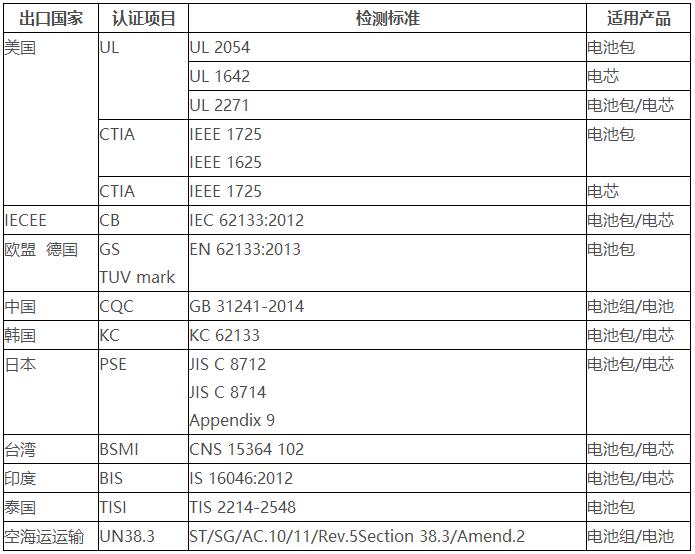Basic introduction
Polymer battery is also called lithium polymer battery (Li-polymer), also known as polymer lithium battery. It is also a type of lithium-ion battery, but it has many obvious advantages such as high energy density, smaller size, ultra-thinning, light weight, and high safety compared with liquid lithium batteries (Li-ion). New battery. In shape, lithium polymer batteries have ultra-thin characteristics, which can be made into batteries of any shape and capacity to meet the needs of various products. The minimum thickness that this type of battery can reach is 0.5mm. Its nominal voltage is the same as Li-ion's nominal voltage of 3.7V and has no memory effect.
National certification standards
Electrochemical performance
1. Fast charging: Under the condition of ambient temperature 20 ± 5 ℃, charge with 200mA constant current to 4.27, and then charge with 4.20 constant voltage until the current will stop at 4.3mA. ;
2. Rated capacity: Under the condition of ambient temperature of 205 ° C, the discharged capacity of the battery cell at 86mA to 2.75V within 1 hour after fast charging is ≥200mAh;
3. Open circuit voltage: ≥4.1V within 24 hours after fast charging;
4. Internal impedance: After fast charging, use an internal resistance meter to test ≤150m.ohm;
5. Cycle life: under the condition of ambient temperature of 20 ± 5 ℃, the rapid discharge and discharge of 300 times at 200mA last capacity ≥160mAh;
6. Low temperature performance: After fast charging, the capacity of discharging at 40mA under the condition of -20 ± 2C is ≥160mAh;
7. High temperature performance: After fast charging, under the condition of 55 ± 2 ℃, the capacity of discharging at 200mA is ≥170mAh;
8. Discharging platform: Under the condition of ambient temperature of 20 ± 5 ℃, the capacity of the battery cell discharged at 40mA to 2.75V within 1 hour after fast charging is ≥140mAh;
9. Charge retention: After fast charging, store at 20 ± 5 ℃ for 28 days, and then discharge at 40mA with a capacity of ≥170mAh
Mechanical behavior
1. Constant humidity and heat performance
After the battery is fully charged, it is placed in a constant humidity and heat box with a temperature of 40 ± 2 ° C and a relative humidity of 90-95% for 48 hours. The battery is taken out and left for 2 hours at a temperature of 20 ± 5 ° C. Visual inspection Appearance of the battery, the discharge time is 200mAh, there is no obvious bulging, rust, smoke, the discharge time is ≥36min
2.Vibration experiment
After fast charging, install the battery on the table of the vibration table, and scan the vibration from 10-55Hz for 30 minutes in the three directions of X, Y and z according to the following frequency and amplitude, and the scan rate is loct / min.
Vibration frequency: 10 ~ 30Hz, single amplitude 0.38mm;
Vibration frequency: 30 ~ 55Hz, single amplitude 0.19nmm;
Requires no apparent damage, cracking, liquid leakage, etc., and the cell voltage is ≥3.6V;
3. Collision experiment
After the battery cell is tested according to 4.2, the battery cell shall be fixed on the table surface in the axial direction of x, Y, and Z on the average, and the experiment shall be performed according to the following requirements:
Pulse peak acceleration -100m / s2;
The number of collisions per minute is -40 ~ 80;
Pulse duration: -16ms;
The total number of collisions is -1000 ± 10;
It is required that the appearance of the battery cell has no obvious damage, cracking, leakage, etc., and the voltage of the battery cell is ≥3.6V;
4. Free fall
After fast charging, drop freely on an 18-20mm thick hardwood board placed on the concrete floor at a height of 1m. After dropping from the X, Y, and Z directions once, perform a charge and discharge cycle, and record the discharge time at 200mA.
Requires no obvious damage, cracking, liquid leakage, etc., discharge time ≥51min
Safety performance
The battery is quickly charged and placed in a hot box after being left for 2 hours. The temperature rises to 130 ± 2 ° C at a rate of (5 ± 2C) / min and is held for 30min;
Requirements: no fire, no explosion
1.Overcharge
Quickly charge the battery cell and leave it for 24 hours, and then charge it with 600mA constant current until the battery cell voltage reaches 5V. After the current reaches zero, the battery cell temperature is about 10 ° C lower than the peak temperature.
Requirements: no fire, no explosion
2. Nail Sting Experiment
After the battery is quickly charged, a steel nail with a diameter of 3 ~ 5mm is used to penetrate the battery from the largest surface of the battery. The battery does not ignite and does not explode.
3.Heavy object impact
After quickly charging the battery cell and leaving it for 24 hours, it was dropped freely from a height of 1 m with a 10 kg weight hammer, and the battery cell fixed in the fixture was impacted. The battery cell did not ignite and did not explode.
4.Short circuit experiment
After quickly charging the battery and leaving it for 24 hours, short-circuit the positive and negative electrodes until the temperature of the battery is about 10 ° C lower than the peak value;
It is required that the battery core does not ignite, does not explode, and the outer surface temperature does not exceed 150 ° C.
Our advantage
 Hot Line
400-800-6106
Hot Line
400-800-6106

